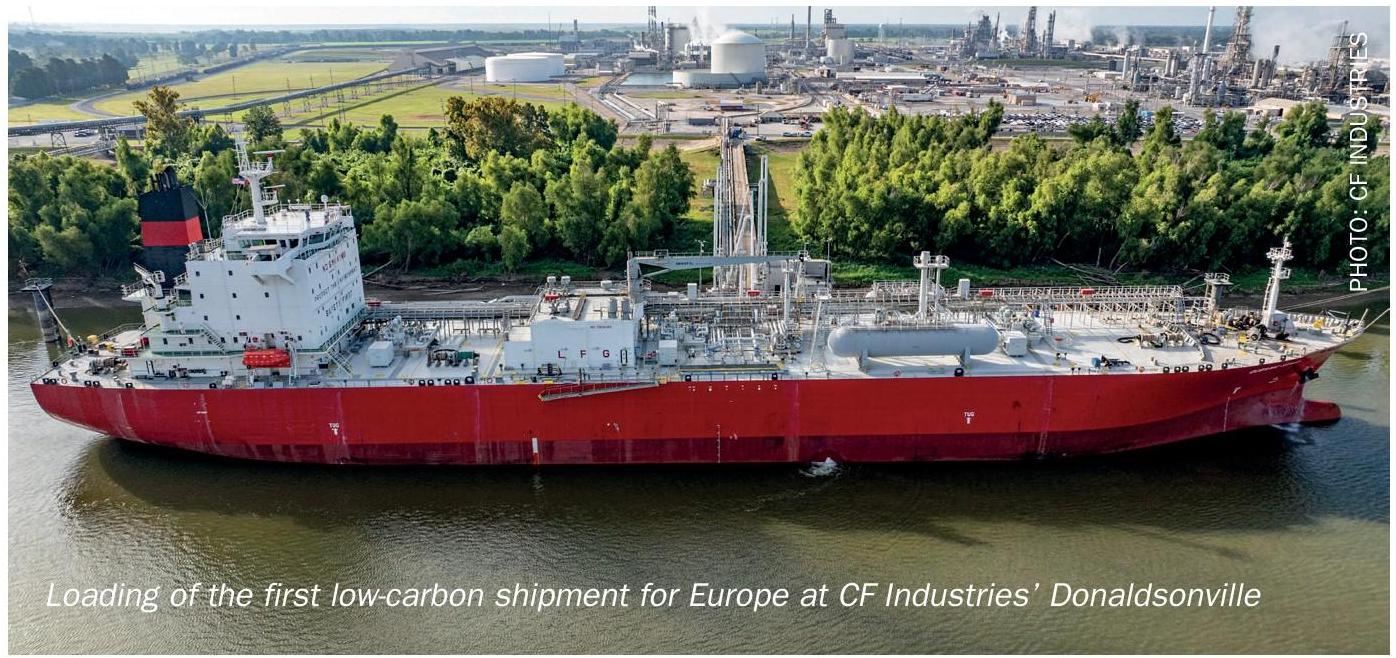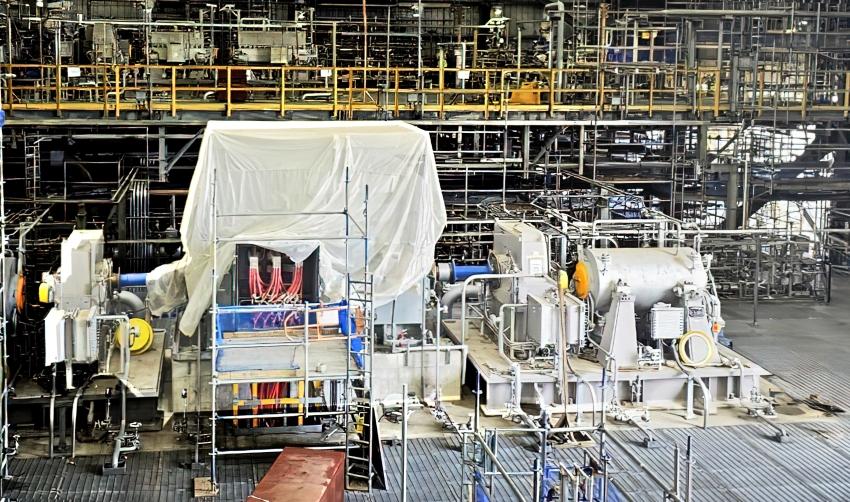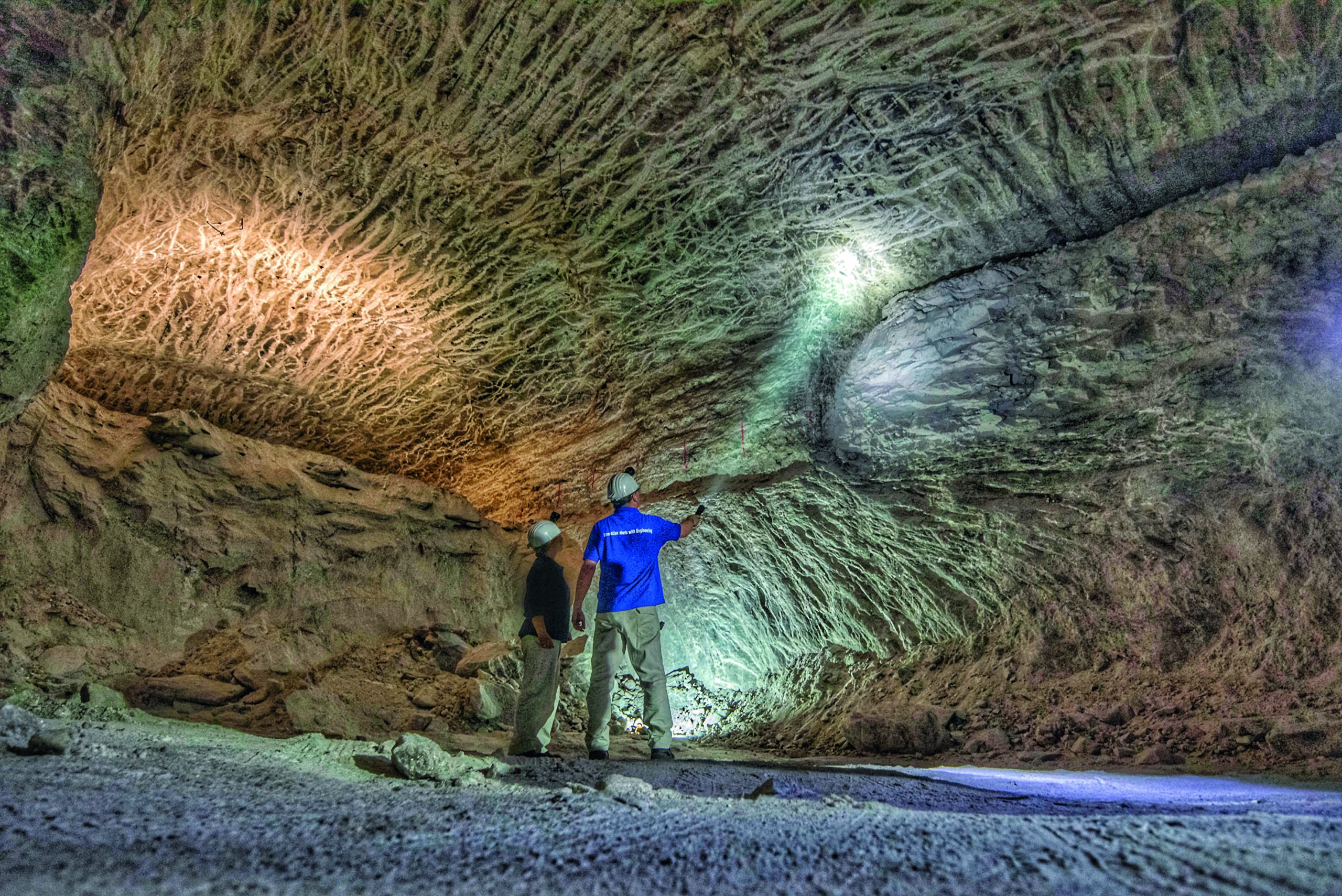Fertilizer International 526 May-Jun 2025

2 May 2025
CBAM – Europe’s low-carbon leap
DECARBONISATION – REGULATORY BRIEFING
CBAM – Europe’s low-carbon leap
Implementation of the European Union’s Carbon Border Adjustment Mechanism (CBAM) is scheduled to start in January next year. In this CRU Insight, Halima Abu Ali and Charlie Stephen look at what forthcoming changes to the EU’s carbon taxation and pricing regimes will mean for the fertilizer industry.

CBAM EXPLAINER
In a nutshell…
• Europe has implemented an emissions trading scheme (ETS) since 2005 – impacting its global competitiveness
• Europe is levelling the playing field, in terms of carbon taxation, through the Carbon Border Adjustment Mechanism (CBAM)
• CBAM initially covers six sectors (cement, iron and steel, aluminium, fertilizers, electricity, hydrogen) but could expand to encompass more
• CBAM will significantly raise the cost of fertilizers and fertilizer raw materials in Europe – this presents opportunities for both European and international fertilizer players
• Demand and policy uncertainty are, however, holding companies back from investing and capitalising on this opportunity
• Importantly, structurally higher fertilizer feedstock costs in Europe will not be fixed by CBAM
Overview
The Carbon Border Adjustment Mechanism (CBAM) and a revised Emissions Trading Scheme (ETS) entered into European Union (EU) law on 16 May 2023. This marked the end of a two-year legislative process which first began with the European Commission’s launch of its ‘Fit for 55 package’ in July 2021.
Now, following a transition period, CBAM is due to be implemented from the start of 2026.
The 2023 reforms to the ETS were designed to reduce carbon emissions by raising the carbon price and extending the scheme’s coverage. The revisions include:
• More ambitious emission reduction targets
• Extending this ‘cap & trade’ scheme to cover more sectors
• Reducing the supply of ETS allowances, i.e. lowering the ‘cap’
• A gradual phase-out of the free allowances currently offered.
CBAM complements the reformed ETS by comprehensively addressing carbon leakage (see below). The aim is to create a level playing field for domestic and foreign producers by charging a carbon tax on imported goods. CBAM will initially apply to imports of cement, iron and steel, aluminium, fertilizers, electricity and hydrogen – as these commodities, and some of their selected precursors, are deemed to be at most significant risk of carbon leakage.
Between October 2023 and December 2025, CBAM only applies as a reporting obligation. This will be followed by the definitive phase of the mechanism from the beginning of 2026.
From that point onwards, importers of designated products will have to purchase and surrender CBAM certificates to pay for the embedded emissions they bring into the EU. Free ETS allowances for the six above-mentioned sectors will also be gradually withdrawn between 2026 and 2034 – while CBAM is phased-in in parallel.
The upshot is that CBAM is poised to financially penalise embedded carbon emissions present in EU imports. The higher the carbon intensity, the greater the cost for the importer. From the start of 2026, a gradual reduction of free allowances under the EU ETS will expose ever larger volumes of emissions to CBAM levies.
For fertilizers, urea will the worst affected by this increased exposure. CBAM should, however, make nitrate fertilizers produced using blue or green ammonia – due to their significantly low emission intensities – an attractive option for importers looking to reduce their costs.
Pre-existing EU policy – the ETS
Launched in 2005, the EU operates the world’s most advanced emission trading system (ETS). This requires polluters to pay for their greenhouse gas emissions. Under the ETS, polluters must surrender one EU Allowance (EUA) for every tonne of CO2 they emit.
The ETS incorporates some safeguards against carbon leakage, a potentially significant consequence of the policy. Carbon leakage occurs when companies, faced with stricter environmental regulations and carbon pricing in one region such as the EU, relocate their production to another region with less stringent or no policies to avoid costs. This is undesirable and damaging for EU industry, as it would lead to the loss of production capacity and plant closures within the region, as well as higher global emissions overall.
To help prevent this, free EUAs are allocated to emitters in those sectors at risk of carbon leakage. The level of free allocation is set by product benchmarks – these representing the average emission level of the 10% most efficient installations within each sector. Any emissions above the free allocation level must be covered by purchasing EUAs. These can be bought at auction or from other emitters with excess EUAs.
The ETS essentially functions as a ‘cap & trade’ market (Figure 1) with a limited amount of EUAs available each year. The supply of EUAs also decreases each year – the aim being to drive up their price, incentivise decarbonisation and as a consequence drive down EU emissions.



CBAM phases in, free allocations phase out
While there is a general acknowledgement that free EUA allowances will eventually need to be removed to drive up decarbonisation, there are justifiable fears that the resulting higher carbon costs within the EU could destroy Europe’s industrial competitiveness – without a protective policy in place. This is the purpose of the Carbon Border Adjustment Mechanism (CBAM).
Essentially, CBAM is designed to reduce carbon leakage by levelling the playing field between EU producers and non-EU producers exporting into the EU.
Under CBAM, importers selling into the EU will be required to pay for the carbon emissions embedded in imported products by purchasing CBAM Certificates (1 CBAM certificate = 1 t CO2). There will be equivalence between the EU ETS and CBAM (Figure 4) in terms of the:
• Level of exposed carbon emissions – as both CBAM and ETS product benchmarks will be equivalent
• Carbon price to be paid – as the price of CBAM certificates is linked to the EUA price.

Under these level playing field arrangements, any carbon cost incurred by the producer in the country of origin is deducted from the CBAM cost. Essentially, this means importers will be exempted from paying CBAM if the country of origin has an equivalent carbon trading scheme.
Importantly, CBAM will be phased-in as free EUA allocations are phased-out (Figure 5). The gradual phase-in of CBAM, by aligning with the phase-out of free allowances under the EU ETS, should result in a smoother regulatory transition.
This will be achieved using a CBAM ‘phase-in factor’. This factor will concurrently:
• Reduce free allocation of EUAs to EU producers, as set by the EU ETS product benchmarks
• While increasing the obligation of importers to buy CBAM Certificates, as set by the CBAM product benchmarks.

Initially, the ETS/CBAM product benchmarks will only be reduced by 2.5%, shielding the bulk of the carbon intensity of products from the carbon price. Eventually, however, both producers in the EU and importers will be fully exposed to the carbon price – from 2034 onwards.
CBAM – preparing for the definitive phase
Under the current EU timetable, the transitional phase of CBAM which began in October 2023 is due to end on 31st December this year. This two year transition is intended to allow companies to get up to speed on reporting requirements, as set out in Table 1.

No CBAM payments are required – just yet. Instead, the emphasis during the transition has been on getting the reporting right. For the fertilizer sector, CBAM covers both direct and indirect emissions (Table 1). The determination of direct embedded emissions is based on actual emissions, unless these cannot be accurately measured. The determination of indirect embedded emissions, meanwhile, are based on default values, unless certain conditions are met.
“The taxation of carbon embedded within imports is on the political agenda in many advanced countries. Businesses would therefore be wise to prepare for other CBAM-like policies that could shape global trade flows in future.”
Affected importers will have to start making CBAM payments once the definitive phase begins, although this requirement has been deferred until 2027, based on recent Commission proposals.
Nonetheless, importers covered by CBAM need to do the following to prepare for the definitive phase of CBAM starting on 1 January 2026:
• First, acknowledge that the transitional phase of CBAM marks a step change in the way the EU engages in international trade. The sooner that affected businesses rise to the challenge of reporting embedded emissions along their supply chain (based on the EU methodology) the better prepared they will be for the definitive phase starting in 2026.
• Second, to avoid double taxation, importers should start keeping track of any carbon taxes or carbon prices they might have paid on emissions that took place outside the EU. While a failure to do so would not result in non-compliance with EU regulations, it would place the company and other non-EU businesses in its supply chain at a competitive disadvantage.
• Third, companies should ensure they are in the position to purchase the required CBAM certificates on the central platform and declare and surrender these when required on the CBAM registry, these covering emissions embedded in imports during the previous calendar year. The first time this will be required will be on 31 August 2027 for the 2026 calendar year.
• Last but not least, companies need to keep on top of developments as the required structures and institutions are not in place yet. These will only be developed over the coming years and – based on experience during the transitional phase – are likely to be launched only just in time for the definitive phase. Policies are also likely to change over time as the European Commission gains practical and operational insights.
What does CBAM mean for the fertilizer industry?
CBAM taxes carbon dioxide (CO2) and nitrous oxide (N2O) embedded in:
• Ammonia Nitric acid
• Urea, ammonium nitrate (AN) and urea ammonium nitrate (UAN)
• Potassium nitrate
• Diammonium phosphate (DAP), monoammonium phosphate (MAP) and NPKs.
CBAM has been applied to a wider selection of fertilizers then originally anticipated, including phosphate fertilizers and potassium nitrate. Europe is a major importer of both nitrogen and phosphates, mainly from the CIS and North Africa. There is a substantial nitrogen production base in Europe and a much smaller phosphate industry.
The extension of the ETS to cover imports of nitrogen and phosphate fertilizers through CBAM means makers of these products destined for the EU market need to review their emissions profiles. Fertilizer exporters/traders targeting the EU will also now need to factor in an additional emissions cost when sourcing products. Producers of fertilizers for the European market will also need to consider this as a factor affecting their competitive position
Impacts – cost and trade flows
Currently, only EU-based emitters face EU emissions costs. This means that, to date, EU prices for imported goods and precursors have not reflected the cost of their embedded emissions. Moreover, so far, manufacturers within the EU have been partially protected from this through the issuance of free allowances.
This will now change. The launch of CBAM, in conjunction with the parallel full withdrawal of free allowances in the EU ETS, will mean that all goods sold in the EU market – regardless of origin – will face EU emissions costs. Over time, the EU market price will begin to internalise this.
CRU expects prices for CBAM goods sold within the EU to increase. This will be a gradual process as the mechanism ramps up over an eight-year period to finally fully apply in 2034.
In terms of trade flows, putting a price on embedded emissions should make higher-emission products imported into the EU less attractive over time. Industries that are currently more dependent on the supply of higher carbon imports will experience a greater shift to trade flows, as CBAM prices gradually kick in over the next eight years.
While European ammonia suppliers gain competitiveness under CBAM, the outlook for regional production remains ominous. Capacity is still likely to close over the coming decade, in CRU’s view, due to a mixture of factors, such as already high production costs, ageing infrastructure, and the impacts of other EU ‘green’ policies (e.g., REDIII). Consequently, European producers looking to maintain downstream fertilizer production within the region are expected to import ammonia from lower cost and less carbon-intensive production centres instead.
Taste of things to come?
It is clear that carbon taxation and the related issue of carbon border adjustments is high on the political agenda in many advanced countries. Businesses would therefore be wise to prepare for other CBAM-like policies that could shape global trade flows in future.
With current climate change mitigation efforts falling short of what is required to achieve the climate ambitions set out in the 2015 Paris Agreement, expect to see more governmental drives to bring down carbon emissions. Carbon pricing and trade policies based on emission intensities will play a crucial role in delivering this.
Businesses in the commodity markets will therefore need to keep on top of these global developments and how they are shaping global trade flows – and should prepare for this as much as they can. Improving emissions measurement across the entire product value chain to meet future stricter emission reporting requirements is one example.
Is CBAM being watered down?
The EU is proposing a one-year delay in the implementation of CBAM, Reuters reported on 24 February, citing a leaked European Commission document.
Specifically, the obligation to purchase CBAM certificates is set to be postponed from 2026 until 2027, providing importers with additional time to prepare for the bloc-wide measure. Costs associated with embedded emissions within 2026 imports will still apply – but will be incurred in 2027 instead.
In addition, companies importing less than 50 tonnes of goods or goods containing less than 100 tonnes of embedded carbon dioxide (CO2) could be exempted from CBAM payments entirely. This new proposal will apparently exempt around 90% of importers from this carbon policy but still cover 99% of emissions.
Acknowledgement
Additional reporting by Simon Inglethorpe and Lewis Walters.
About the authors

Halima Abu Ali is CRU’s Analyst for Fertilizer Costs and Emissions.
Tel: +44 20 7903 2165

Charlie Stephen is CRU’s Lead Analyst for Nitrogen and Hydrogen.
Tel: +44 20 7903 2277






